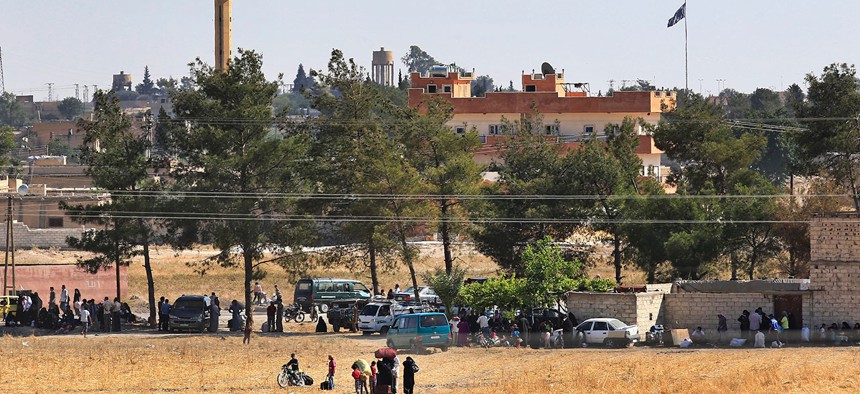
Syrian refugees walk on the Syrian side of the border as they approach in order to cross into Turkey in June. Lefteris Pitarakis/AP
It Takes the Federal Government Two Years to Process a Refugee Application from Syria
More than four million Syrians have left their homes since civil war broke out in 2011.
More than four million Syrians have left their homes since civil war broke out in 2011, with roughly three million fleeing to neighboring countries, such as Jordan and Turkey. Many are now either in Europe or trying to get there to apply for asylum. After seeking refuge, there are still thousands who are at risk in their host country, and the United Nations applies for these refugees to be resettled elsewhere.
But once the US agrees, in theory, to resettle a refugee, authorities then begin a laborious vetting process that can take up to two years, a State Department spokesman told Voice of America.
The refugees, who have already been vetted by the UN, must then be screened by US authorities—involving the National Counterterrorism Center, the Terrorist Screening Center, the Department of Defense, the FBI, and Homeland Security officers, former State Department spokeswoman Jen Psaki said in February.
Syrians who have been approved for resettlement are often survivors of torture, female-led families without protection, and unaccompanied minors. They can be in danger throughout the vetting process, and delays are common, Daryl Grisgraber, senior advocate for the Middle East and North Africa at Refugees International, tells Quartz.
“Once the person is cleared medically, that medical clearance may even expire while the security check is happening,” she says from Washington. “There’s a whole cycle that makes the process quite slow.”
Syrian refugees face particularly long delays because of anxieties about terrorism in the Middle East. But excessive fears can make the resettlement process redundant. The US does not accept refugees who have given “material support” to armed groups, but this has previously been used to block people for the slightest excuse—a Burundi refugee was detained for 20 months because armed rebels robbed him of $4 and his lunch. The immigration judge decided this counted as “material support.”
The US trains and supports some Syrian rebel fighters and so it changed the requirements in February so that refugees who gave “insignificant material support” are not automatically blocked. But getting an exemption waiver to show that, for example, material support was given under duress, can take a long time, Grisgraber says.
The US expects to have admitted just 1,800 Syrian refugees from 2011 when the Arab Spring began until the end of October 2015—though resettlement agencies are calling for the US to accept 65,000 Syrian refugees.
Refugees who are stuck in a resettlement process and struggling to feed their family could be tempted find sanctuary through more dangerous routes–such as being smuggled on boats to Europe illegally. “If you can’t feed your kids, what are you going to do?” says Grisgraber. “You’re going to try to move onto the next place where you might put some food on the table for them.”
Taking two years to process a refugee isn’t just a bureaucratic drain. It also puts Syrians in danger.






